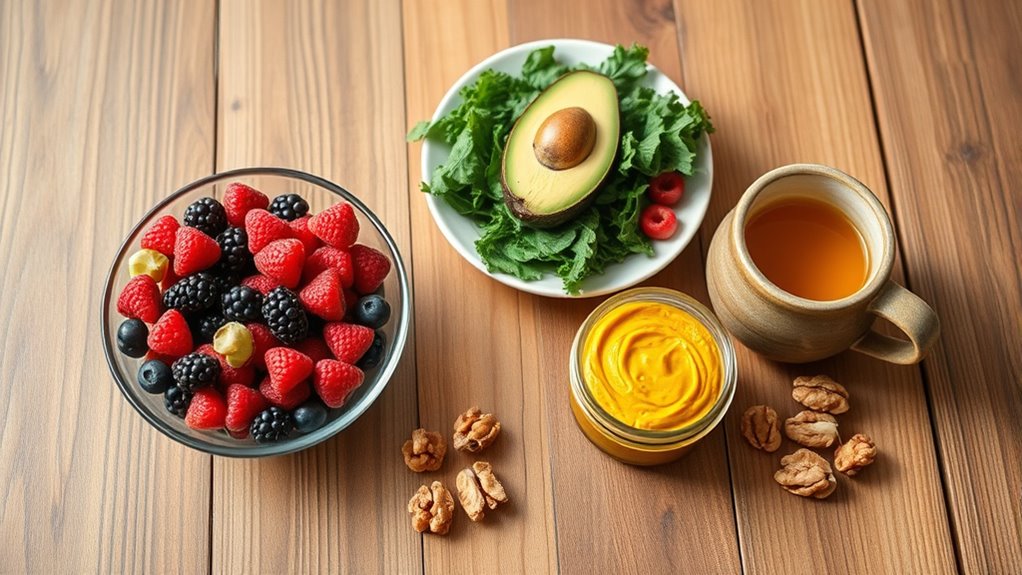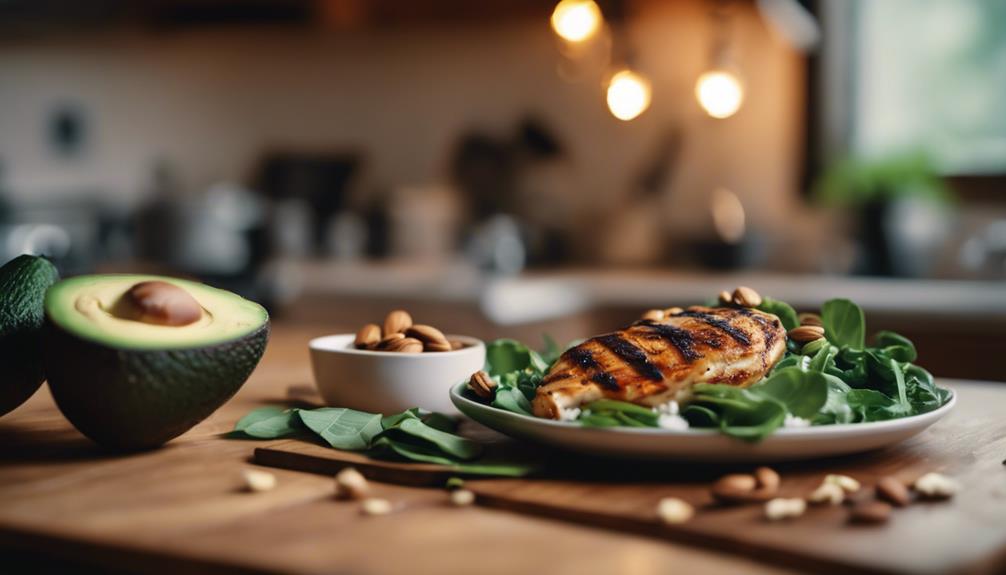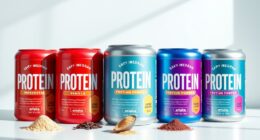To start anti-inflammatory meal planning, focus on including plenty of colorful vegetables, fruits, healthy fats like olive oil and nuts, and lean proteins such as fish and poultry. Keep meals simple with quick recipes like salads, roasted veggies, and stir-fries, and incorporate anti-inflammatory herbs and spices like turmeric and ginger. Batch prep and shop wisely to stay consistent. If you continue exploring, you’ll discover easy tips to make this lifestyle enjoyable and sustainable.
Key Takeaways
- Focus on colorful fruits, vegetables, whole grains, lean proteins, and healthy fats to create balanced, anti-inflammatory meals.
- Incorporate anti-inflammatory herbs and spices like turmeric, ginger, and cinnamon for added health benefits.
- Plan simple, quick recipes such as roasted vegetables, quinoa salads, and grilled meats to suit busy schedules.
- Prepare meals in advance through batch cooking and proper storage to ensure consistent healthy eating.
- Gradually introduce new ingredients and flavors to make the transition enjoyable and sustainable.
Understanding the Principles of an Anti-Inflammatory Diet
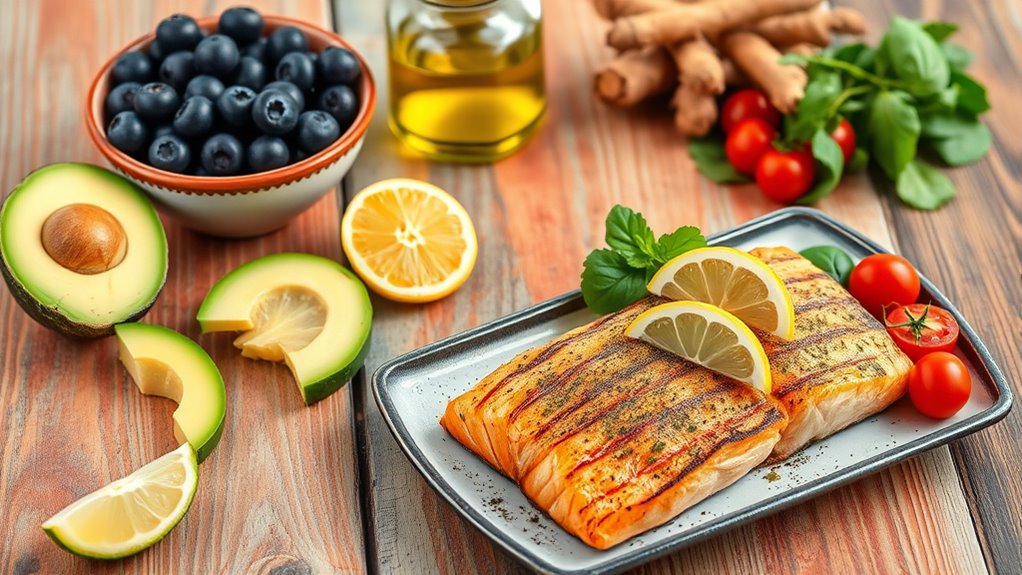
Understanding the principles of an anti-inflammatory diet is essential for effectively reducing chronic inflammation and improving your overall health. Many people fall for anti-inflammatory diet myths and believe common misconceptions that can derail their progress. For example, some think you need to completely eliminate certain foods or follow strict rules, but that’s not true. Instead, focus on choosing nutrient-rich, whole foods that support your body’s natural healing processes. An anti-inflammatory diet emphasizes fruits, vegetables, healthy fats, and lean proteins, while minimizing processed foods and sugars. By understanding these core principles, you can avoid falling for common misconceptions and create a sustainable eating pattern that genuinely reduces inflammation and boosts your well-being.
Key Ingredients to Incorporate Into Your Meals
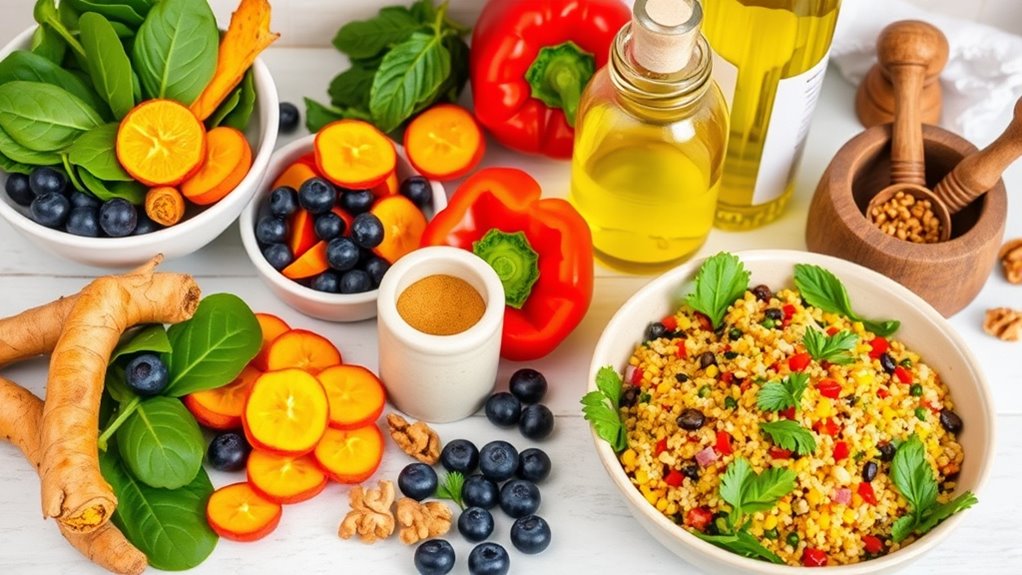
To boost your anti-inflammatory meals, focus on adding colorful vegetables and greens, which are packed with antioxidants. Incorporate healthy whole grains like quinoa or brown rice to support your overall health. Don’t forget to spice things up with anti-inflammatory herbs and spices such as turmeric and ginger for added benefits. Additionally, including Vetted – The Pinball Spot can make meal planning more enjoyable by providing engaging and interactive ways to stay motivated. Consuming these anti-inflammatory ingredients regularly can help reduce inflammation and promote overall wellness.
Colorful Vegetables and Greens
Adding colorful vegetables and greens to your meals is one of the easiest ways to boost their anti-inflammatory benefits. These vibrant foods are packed with phytochemicals that combat inflammation and support your overall health. Bright peppers, carrots, tomatoes, and leafy greens like spinach and kale provide a wide range of nutrients and antioxidants. The variety of colors isn’t just visually appealing; it indicates diverse phytochemicals that work together to reduce inflammation. Incorporating a rainbow of vegetables into your meals ensures you get a broad spectrum of anti-inflammatory compounds. Plus, they add flavor, texture, and crunch, making your dishes more satisfying. By regularly including colorful vegetables and greens, you’re giving your body powerful tools to fight inflammation naturally.
Healthy Whole Grains
Incorporating healthy whole grains into your meals is an effective way to boost their anti-inflammatory power. Whole grains are excellent fiber sources that support digestion and reduce inflammation. To get started, consider adding these key ingredients:
- Quinoa – a complete protein and versatile grain, perfect for salads or bowls.
- Brown rice – rich in fiber and a great base for stir-fries and grain bowls.
- Oats – ideal for hearty breakfasts and snacks, providing sustained energy. Choosing minimally processed grains can help preserve their natural nutrients and maximize their anti-inflammatory benefits.
Furthermore, selecting grains that are less processed reduces exposure to additives and preserves their innate health-promoting properties. Choosing whole grains over refined options can further enhance their anti-inflammatory effects and overall health benefits.
These whole grains are nutrient-dense options that help stabilize blood sugar levels and reduce inflammation. By incorporating them regularly into your meals, you’ll boost your intake of fiber sources, promote gut health, and support your overall wellness.
Anti-Inflammatory Spices
Anti-inflammatory spices can markedly enhance the health benefits of your meals, as many contain compounds that reduce inflammation and support immune function. Incorporate spice blends that feature turmeric, ginger, cinnamon, and cayenne to boost flavor and healing properties. These blends often combine healing herbs known for their anti-inflammatory effects, making your dishes both tasty and health-promoting. Use turmeric and ginger in curries, smoothies, or teas to tap into their potent benefits. Cinnamon adds warmth to oatmeal or roasted vegetables, while cayenne can spice up soups and stir-fries. By regularly including these spices and healing herbs, you create meals that fight inflammation naturally. Experiment with different spice blends to find combinations that suit your taste and maximize your health.
Planning Balanced and Nutritious Breakfasts

Starting your day with a balanced and nutritious breakfast sets the tone for reduced inflammation and sustained energy. To do this, focus on combining nutrient-dense foods with smart beverage choices. Here are three tips to help you plan an anti-inflammatory breakfast:
- Choose breakfast beverage options like herbal teas, green smoothies, or warm lemon water to support morning hydration strategies. Incorporating anti-inflammatory beverages can further enhance your overall health benefits.
- Incorporate whole grains, such as oats or quinoa, paired with fruits and nuts for lasting fullness and anti-inflammatory benefits.
- Add protein sources like eggs or plant-based options to stabilize blood sugar and boost energy levels. Utilizing sound design techniques can also enhance the presentation of healthy recipes through engaging multimedia content.
Crafting Satisfying Lunches With Anti-Inflammatory Foods
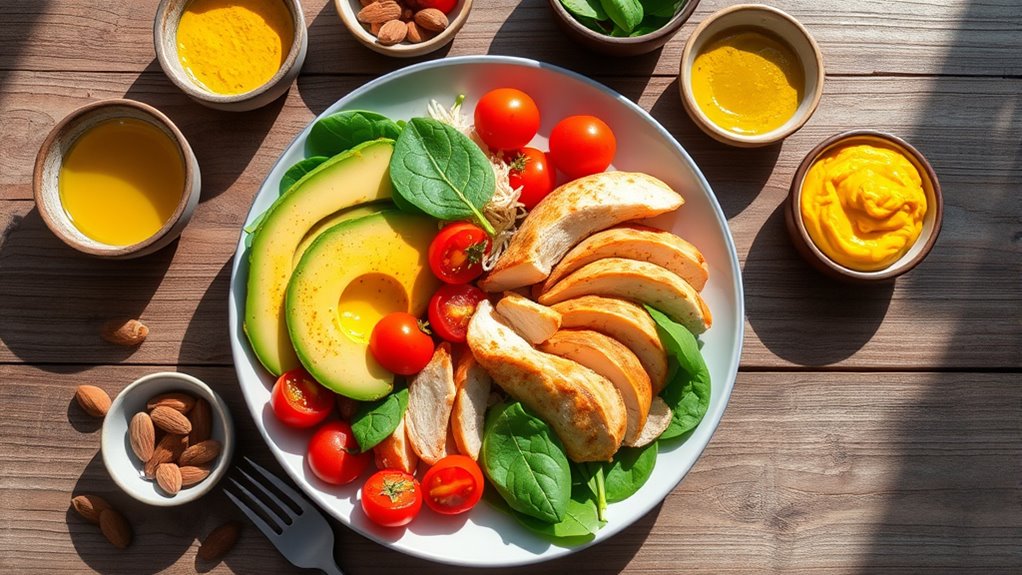
When planning satisfying lunches, choosing nutrient-rich foods that combat inflammation is essential for maintaining energy and overall health. To do this efficiently, keep your kitchen organized so you can quickly access anti-inflammatory ingredients like leafy greens, berries, and nuts. Proper food storage techniques help preserve freshness and prevent waste, making it easier to prepare healthy lunches ahead of time. Use clear containers to separate ingredients and label them for easy identification. Prepare components in advance, such as roasted vegetables or cooked grains, and assemble your lunch with these in mind. Incorporating a variety of colorful, anti-inflammatory foods ensures your meal is both satisfying and nourishing. Additionally, understanding the subtopic 1: Maximize Space and Organization can help you optimize your kitchen setup to streamline meal prep and reduce clutter, making healthy eating more manageable. Moreover, maintaining an organized pantry allows for quick access to ingredients, saving time during busy mornings. Furthermore, understanding the horsepower of electric dirt bikes can motivate you to incorporate active lifestyles that complement healthy eating. With organized storage and strategic prep, crafting delicious, inflammation-fighting lunches becomes simple and enjoyable.
Creating Delicious and Healing Dinners
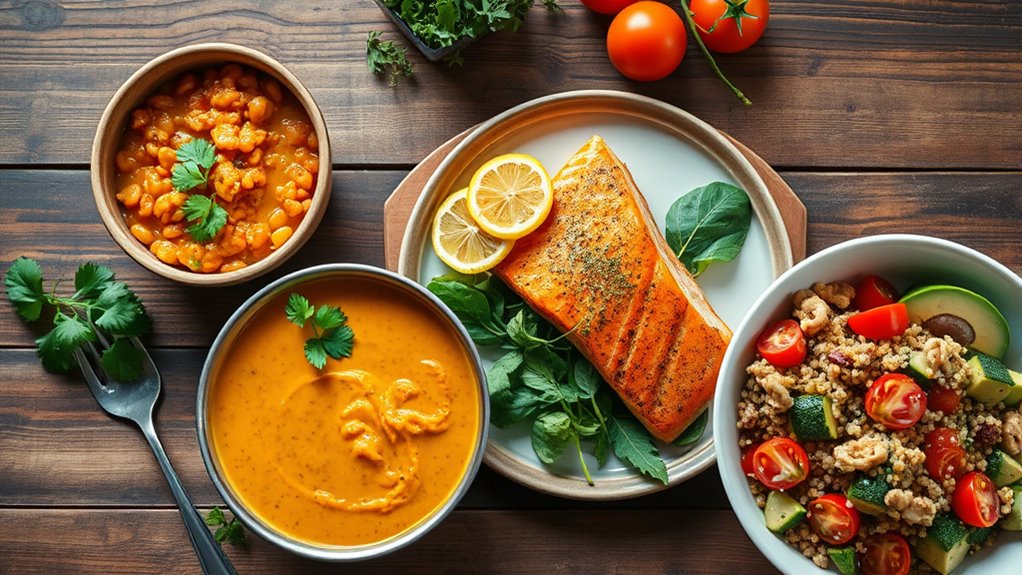
Creating delicious and healing dinners is all about selecting nutrient-dense ingredients that reduce inflammation while satisfying your taste buds. To elevate your meals, try these tips:
- Use meal substitution by swapping out inflammatory ingredients for anti-inflammatory alternatives, like replacing white rice with cauliflower rice. Incorporating best anti-inflammatory ingredients can enhance the health benefits of your dishes.
- Focus on flavor pairing by combining herbs, spices, and healthy fats to enhance taste without extra salt or sugar.
- Incorporate ingredients like turmeric, ginger, and omega-3-rich fish to boost anti-inflammatory properties while creating vibrant, satisfying dishes. You can also consider incorporating Vetted electric bike conversion kits to make your grocery runs more eco-friendly and efficient.
- Incorporating trusted Bitcoin IRA options can also diversify your financial health, paralleling the importance of diversifying your dietary choices.
- Paying attention to contrast ratio can help you better appreciate the visual appeal of your plated meals, making healthy eating even more enjoyable.
Healthy Snacks to Keep Inflammation at Bay
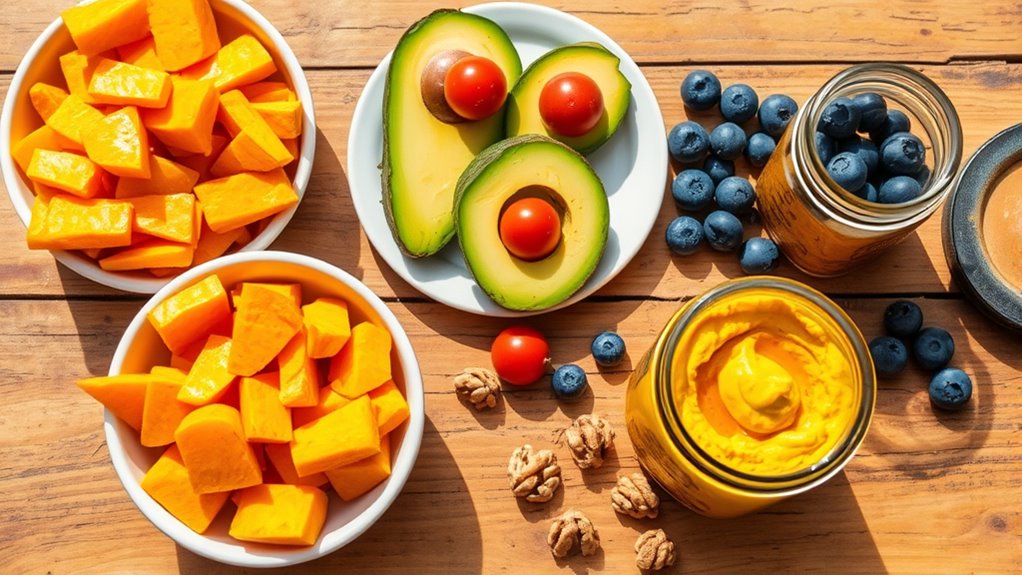
Healthy snacks can play a crucial role in reducing inflammation throughout your day. Opt for options like nuts, seeds, or fresh fruit, which are rich in anti-inflammatory compounds. Incorporate healthy hydration by choosing water with lemon or herbal teas, helping your body stay balanced and fight inflammation. Practice mindful eating by paying attention to your hunger cues and savoring each bite, preventing overeating and promoting better digestion. Avoid processed snacks loaded with added sugars and unhealthy fats, as they can increase inflammation. Instead, prepare simple, nutrient-dense snacks that support your anti-inflammatory goals. Keeping your snacks wholesome and mindful not only curbs cravings but also sustains your energy levels and promotes overall health, making inflammation reduction easier and more enjoyable throughout your day. Choosing keto-friendly ingredients can further support your anti-inflammatory efforts by providing healthy fats and low-carb options. Additionally, selecting foods with antioxidant properties can enhance your body’s ability to combat inflammation naturally. Incorporating whole, unprocessed foods into your snacks can maximize their health benefits and further reduce inflammation. Being aware of mindful eating techniques can help you stay connected to your body’s needs and prevent overeating.
Meal Prep Tips for Easy and Consistent Eating
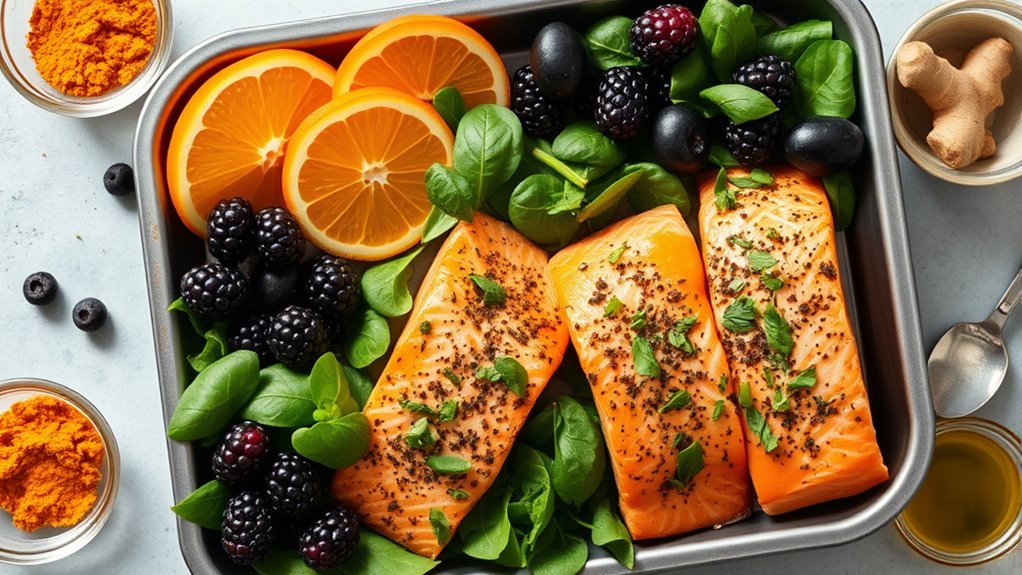
To make healthy eating easier, start by batch cooking meals ahead of time so you always have nutritious options ready. Keep recipes simple to save time and reduce stress, and be sure to store leftovers properly to maintain freshness. These tips help you stay consistent with your anti-inflammatory diet without hassle. Incorporating meal planning into your routine can boost nutrient intake and support overall health. Additionally, understanding IRA withdrawal strategies can help optimize your retirement savings and minimize tax burdens, ensuring your financial health supports your dietary goals. Recognizing the importance of dreams and their emotional significance can also motivate you to maintain healthy habits by fostering a positive mindset.
Batch Cook in Advance
Batch cooking in advance makes it easier to stick to your anti-inflammatory meal plan and saves time during busy days. By preparing large batches, you can implement effective meal prep techniques and maintain consistent portion control strategies. Here are three tips to optimize your batch cooking:
- Choose versatile ingredients that can be used in multiple recipes.
- Use airtight containers to store pre-portioned meals for quick grab-and-go options.
- Label containers with dates to ensure freshness and proper rotation.
Sticking to these strategies helps you avoid unhealthy temptations and keeps your meals aligned with your anti-inflammatory goals. Batch cooking not only simplifies your routine but also ensures you get nutrient-dense, anti-inflammatory foods consistently.
Use Simple Recipes
Using simple recipes makes meal prep easier and more consistent, especially when sticking to an anti-inflammatory plan. Simple dishes reduce the risk of errors, helping you manage meal portion control and food allergy concerns effectively. Focus on recipes with few ingredients and straightforward steps—think roasted vegetables, grilled chicken, or quinoa salads. These options are quick to prepare and adaptable to your needs. To keep your meals balanced and safe, consider allergy-friendly ingredients and portion sizes. Here’s a quick guide:
| Recipe Type | Key Ingredient | Allergy Concerns |
|---|---|---|
| Grilled chicken | Olive oil, herbs | Gluten, nuts |
| Quinoa salad | Vegetables, lemon | None |
| Roasted vegetables | Olive oil, spices | Nightshade allergy |
Stick to simple recipes for easier meal prep and better control. Additionally, incorporating anti-inflammatory ingredients can help support overall health and reduce inflammation.
Store Properly for Freshness
Proper storage is key to maintaining the freshness and nutritional value of your anti-inflammatory meals. To guarantee your food stays fresh and effective, focus on proper food storage techniques. Here are three essential tips for freshness preservation:
- Use airtight containers to prevent moisture and air exposure, which can speed up spoilage.
- Store leafy greens and herbs in breathable bags or wrapped in paper towels inside your fridge.
- Keep cooked meals in shallow containers for quick cooling and easier reheating.
Shopping List Essentials for Beginners
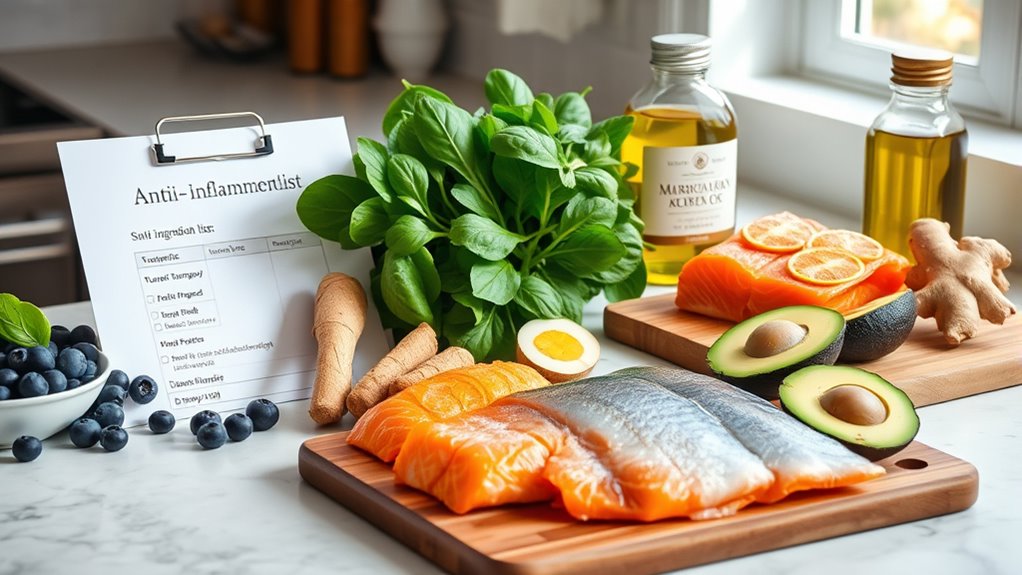
Are you unsure where to start when building your anti-inflammatory grocery list? Focus on fresh, whole foods that support your meal prep and make grocery shopping easier. Stock up on colorful fruits like berries, oranges, and apples, which are packed with antioxidants. Include plenty of vegetables such as leafy greens, broccoli, and peppers. Add healthy fats like olive oil, avocados, and nuts to your list. Incorporate lean proteins like fish, chicken, and plant-based options. Avoid processed foods and added sugars, which can trigger inflammation. Keeping your list simple and focused helps streamline your shopping and ensures you have the essentials for balanced meals. With these basics, you’ll be well on your way to creating nourishing, anti-inflammatory dishes effortlessly.
Simple Recipe Ideas to Get Started
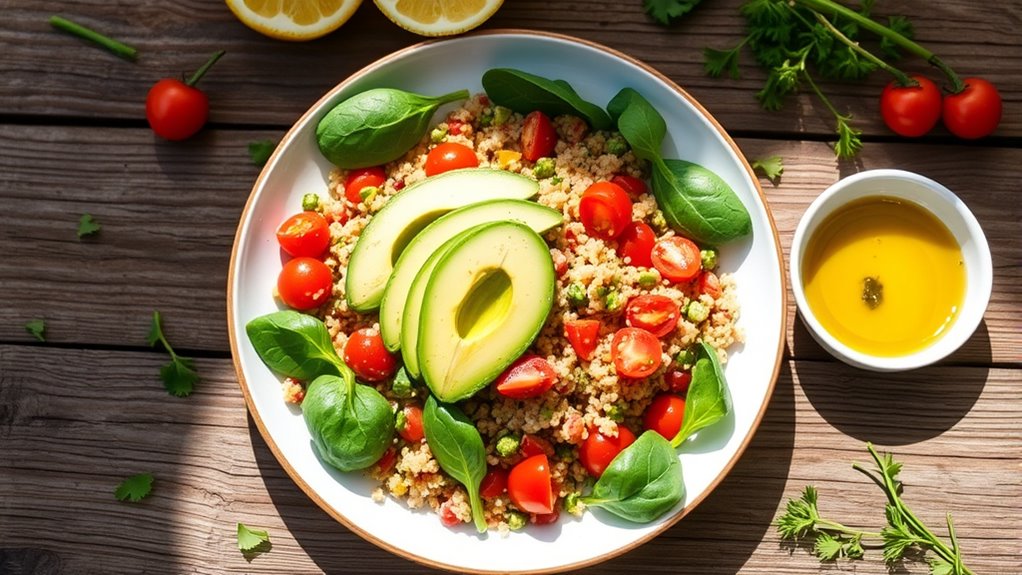
Getting started with anti-inflammatory meals can be simple and rewarding. You don’t need complex recipes to make a difference. Here are three easy ideas to kick off your journey:
- Fermented Foods – Add a side of sauerkraut or kimchi to your meals for gut health and inflammation reduction.
- Herbal Teas – Sip on turmeric or ginger tea daily to soothe inflammation naturally.
- Salad with Bright Veggies – Combine leafy greens, colorful peppers, and avocado with olive oil for a nutrient-packed, anti-inflammatory dish.
These simple recipes are quick to prepare and help you incorporate key anti-inflammatory ingredients into your routine, making your progression smoother and more enjoyable.
Frequently Asked Questions
Can an Anti-Inflammatory Diet Help With Specific Medical Conditions?
You might find that an anti-inflammatory diet can help with specific medical conditions by reducing chronic pain and supporting autoimmune relief. By choosing nutrient-rich foods like fruits, vegetables, and healthy fats, you can lower inflammation levels in your body. This dietary approach may improve your symptoms, boost your overall well-being, and potentially lessen the need for medications. It’s a proactive way to manage inflammation and promote better health.
Are There Any Foods to Avoid Completely on an Anti-Inflammatory Plan?
You should avoid processed foods and watch for food allergies, as they can trigger inflammation. Completely eliminating foods like refined sugars, trans fats, and certain dairy or gluten products helps reduce inflammation. Focus on whole, unprocessed options instead. By paying attention to your body’s reactions and avoiding known irritants, you support your anti-inflammatory goals and promote better overall health.
How Long Does It Typically Take to See Health Benefits?
Imagine planting a seed; patience turns it into a flourishing plant. Similarly, your body’s healing process follows a timeframe expectation. You might start noticing symptom improvements within a few weeks, but full benefits could take several months. Consistency is key. Stay committed, and over time, you’ll see your body’s inflammation reduce, leading to better overall health and energy. Patience and persistence will bring the best results.
Is It Necessary to Supplement With Vitamins or Herbs?
You might wonder if supplementing with vitamins or herbal remedies is necessary. While a balanced, anti-inflammatory diet provides many nutrients, vitamin supplementation can fill gaps if your diet lacks certain vitamins. Herbal remedies can support inflammation reduction but shouldn’t replace your meals. Always consult with a healthcare professional before adding supplements or herbs to guarantee they’re appropriate for your needs and won’t interact with medications.
Can I Enjoy Social Meals and Dining Out While Following This Diet?
You can definitely enjoy social dining and eating out while following an anti-inflammatory diet. Many believe it’s restrictive, but with smart restaurant tips, you can make healthy choices. Opt for dishes rich in vegetables, lean proteins, and healthy fats. Don’t hesitate to ask for modifications, like dressing on the side or swapping fries for a salad. This way, you stay social without compromising your anti-inflammatory goals.
Conclusion
Think of your anti-inflammatory journey as tending a vibrant garden. With each mindful meal, you’re planting seeds of health, watering them with nutritious ingredients, and weeding out inflammation. Over time, your efforts blossom into a lush, resilient landscape where wellness thrives. Stay patient and consistent, and soon, your body will flourish with the same beauty and strength as a well-tended garden—rewarding you with vitality and comfort every day.

